Creating the perfect spa environment goes beyond just beautiful design; it is about crafting a sanctuary for relaxation and rejuvenation. Whether your project is a personal home spa or a commercial wellness facility, careful attention to layout is vital. An effective floor plan maximizes usability and enhances the overall client experience. In this article, we will delve into various spa layouts tailored to meet diverse needs and preferences. Initially, contemplate the spatial flow. A well-crafted spa layout should facilitate smooth transitions between areas such as the reception, treatment rooms, relaxation zones, and hydrotherapy sections. This design ensures that clients can navigate seamlessly from one service to another without feeling hurried or cramped. A favored layout option features dedicated zones for different treatments. For example, begin with a calming entryway that includes a welcoming reception area. Then, establish separate treatment rooms designated for massages, facials, and other services. Each room should exude its own ambiance, allowing guests to fully immerse themselves in tranquility. Furthermore, incorporating a relaxation area for clients to unwind before and after treatments would enhance the experience. This area could include comfortable seating, gentle lighting, and even soothing music or a water feature. Alternatively, consider an open-concept spa layout, which supports a more communal atmosphere. This design is particularly suited for spas that promote social interaction and group therapies. An expansive central space could host multiple treatment stations, surrounded by semi-private areas for more individualized services. This setup cultivates a sense of community and can significantly enhance the overall client experience. When designing your floor plan, remember to include essential amenities such as locker rooms, bathrooms, and showers. These facilities need to be accessible yet provide privacy. Adequate storage for both supplies and equipment is crucial to maintaining a tidy environment. Additionally, think about adding a retail section where clients can purchase products used in their treatments. This feature not only enhances the client’s experience but also has the potential to increase revenue. Lighting is another critical aspect of spa design. Employing soft ambient lighting cultivates a soothing atmosphere, while natural light can create an inviting feel. Take into account the placement of windows and how they can be harnessed to introduce natural light without sacrificing privacy. When selecting materials, choose calming colors and textures that resonate with the theme of relaxation and wellness. In conclusion, crafting effective spa layouts requires careful thought regarding flow, function, and ambiance. Whether you opt for a traditional layout or an open design, the objective should always be to create a peaceful haven that encourages relaxation and rejuvenation. With the right design approach, your spa can serve as a refuge for those seeking respite from the demands of everyday life. As you embark on your dream project, consider using innovative design software like Homestyler to visualize your space before implementing any changes. Remember, every element matters in creating the ultimate spa experience, from the layout to the finishing touches. So unleash your creativity and design the spa you’ve always dreamed of!
Tips 1:
In designing your spa, it is crucial to prioritize comfort and serenity in every aspect of your layout.
FAQ
What should a spa layout include? An effective spa layout typically encompasses a reception area, treatment rooms, relaxation spaces, as well as essential amenities like locker rooms and showers.
How can I optimize the flow in my spa design? Achieve an organized flow by ensuring pathways are unobstructed and creating designated zones for various services.
welcome to Homestyler























































